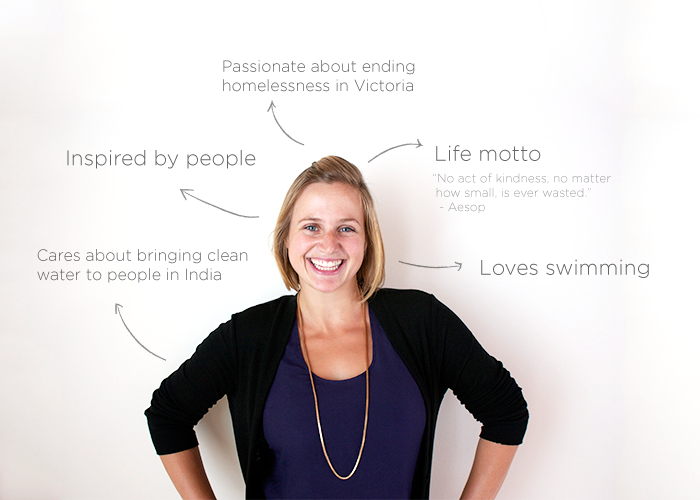Q&A: How To Plan Your Annual Fundraising
February 11, 2015
6 min read
The first two things welcoming visitors to Frontier, a Victoria-based marketing company, are the smell of fresh coffee and music playing softly in the background.
In the centre of the open concept office, a cluster of people is working away at a long communal desk. And somewhere among them sits Emily Cheevers, hunkered over her laptop, or exchanging the latest charity news with a colleague, or anticipating Frontier’s next Taco Tuesday, her favourite office event.
[tw-divider]
Meet Emily
[/tw-divider]

As Frontier’s Managing Director, Emily works closely with charities seeking help with fundraising strategy, public relations, multi-year business planning and much more.
“I have to wear many hats on a daily basis,“ she says laughing. “It’s fun though. I like working with a wide range of charities. It’s really inspiring to get to know them and the work they’re doing.”
Today, Emily will draw from her host of experience and share some nuggets of wisdom on crafting an annual fundraising plan, along with some best fundraising practices.
[tw-column width=”one-third”]
Why is it important to plan your fundraising ahead of time?
[/tw-column]
[tw-column width=”two-third” position=”last”]
It’s important because it helps you to see where you’re going as an organization. For example, do I want to remain a grassroots organization or do I want to grow into a bigger charity? So, creating a 1-year, 2-year, or 5-year plan really shows you that big picture.
[/tw-column]
[tw-column width=”one-third”]
What’s the best time to overhaul your fundraising strategy?
[/tw-column]
[tw-column width=”two-third” position=”last”]
There are definitely better times in the year to make changes. You don’t want to overhaul your system in October or November when you’re heading into prime fundraising season. For most charities we work with, regardless of when they approach us, we suggest a staggered approach so that change can happen gradually.
[/tw-column]
[tw-column width=”one-third”]
What are the most important components of a fundraising plan?
[/tw-column]
[tw-column width=”two-third” position=”last”]
We look at four components: digital, annual, monthly giving and new donors.
Digital, because that’s where a lot of giving and information gathering is happening these days. Annual giving is very much about stewardship and cultivation of donors, and monthly giving sets the future. New donors, or acquisition, is often the hardest part and the part that costs most with little immediate financial return. But attracting new donors is the most crucial component in setting a charity up for long-term success.
If you’re doing well with all four aspects you have a solid plan.
[/tw-column]
[tw-column width=”one-third”]
What’s your number one piece of advice for charities when it comes to fundraising?
[/tw-column]
[tw-column width=”two-third” position=”last”]
It’s important to add a personal touch when you’re talking to your supporters. People don’t want to feel like they’re just a number, they want to feel connected. It’s really important for retaining donors. If someone gave $25 and doesn’t give again, it’s because they don’t feel that there is a relationship and they don’t feel like they are making a difference.
Ben [Johnson], our Executive Director, often uses the analogy of the second cousin to explain this idea. You write a Christmas letter to your second cousin at Christmas, and that’s probably all the communication you have for the year. But with your sister or brother you probably talk a lot more often and you’re much closer.
As a charity, you don’t want to have second cousin relationships with your donors.
You want to communicate often and in a meaningful way by being accountable for what you’re doing and by telling your charity’s story. There’s that misconception that donors get frustrated when they’re being communicated with, but really what they want is to feel connected.
[/tw-column]
[tw-column width=”one-third”]
When you start working with new charities, what is the first step to figuring out what their needs are?
[/tw-column]
[tw-column width=”two-third” position=”last”]
We always recommend doing an audit. We look at a charity’s database, current and past donors, giving history and so on. We ask questions like ‘Where are they losing donors? What about acquisition? How is that going? What about their online presence, their branding or analytics?
We try to create the whole picture of where the organization came from and where it wants to go. It gives us a better idea of what to focus on.
For one charity it might make sense to focus on acquisition. For another, building stewardship to retain donors is more important.
So, ultimately we try hard to get at the heart of the organization, so that we can give them the tools they need and are able to capture their heart and voice when we work with them.
[/tw-column]
[tw-column width=”one-third”]
What are barriers charities are facing in their fundraising efforts?
[/tw-column]
[tw-column width=”two-third” position=”last”]
It really depends on the charity, but often it’s resources. Many charities need that one person who can do everything because of limited financials. That’s where Frontier comes in. We have all those resources from design or programming to writing, donor communication and so on. When you work with us, you get direct access to specialists.
[/tw-column]
[tw-column width=”one-third”]
Do you have a favourite “success story”? Maybe a charity you recently worked with?
[/tw-column]
[tw-column width=”two-third” position=”last”]
I’m really proud of our work with the Victoria Dandelion Society. When we started working with them they were a $25,000 charity and now they have grown to $210,000.
The organization is driven by one man, Reverend Al, and he works with Victoria’s street community by helping out wherever help is needed. So, there’s no specific programming, which is a bit of a tough sell. We put together a video showing a day in the life of Reverend Al and revamped their website. I think the website and the video capture the spirit of the Dandelion Society as a grassroots, community-driven organization.
It was great to play a role in giving a poverty-based organization its own voice and to see that people connect with the organization on a personal level.
[/tw-column]
Want to learn more about how to keep donors happy, engaged and connected? Join us for a webinar with storytelling whiz Vanessa Chase on Donor Communications: Using Stories that Add the “Wow!” Factor to learn storytelling strategies you can use today!
